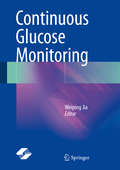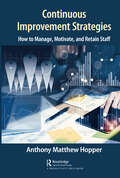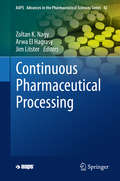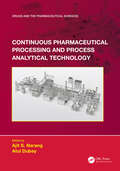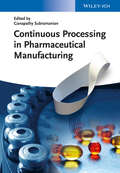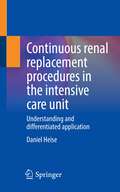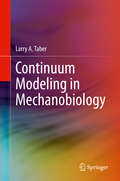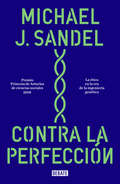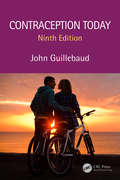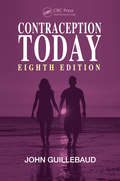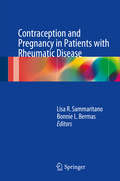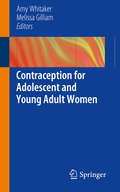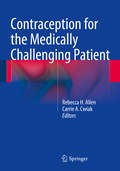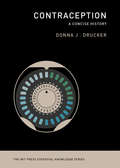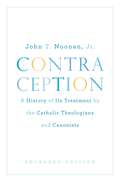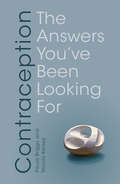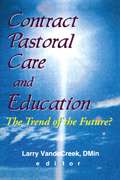- Table View
- List View
Continuous Glucose Monitoring
by Weiping JiaThis book provides comprehensive information on continuous glucose monitoring (CGM). The first section focuses on the fundamentals of CGM technology, including the principles of CGM, accuracy assessment, operation procedure, management processes, the picture-interpretation methodology, the clinical value of CGM parameters, reference values, clinical applications of CGM report and management systems, and clinical indications. In turn, the second section describes the clinical application of CGM, including assessing blood glucose fluctuation and hypoglycemic effects, detecting hypoglycemia and identifying fasting hyperglycemia. It also describes the role of CGM in connection with specific diseases, such as fulminant type 1 diabetes, gestational diabetes mellitus, steroid diabetes, and insulinoma. The closing chapter outlines the future of CGM. In addition, the book presents typical cases and analyses of nearly a hundred typical monitoring maps. As such, it offers diabetic health care doctors a valuable reference guide to the clinical application of and scientific research on CGM.
Continuous Improvement Strategies: How to Manage, Motivate, and Retain Staff
by Anthony Matthew HopperDuring this era of continuous improvement, healthcare organizations need to be staffed by engaged, motivated, and hard-working frontline employees. As these clinical and non-clinical personnel handle most of the important tasks in any organization and are often the people who directly interact with patients and customers, it's the job of managers to oversee and motivate their staff members. Using Lean management strategies, this easy-to-read book for leaders and managers provides useful, insightful, and innovative information to help managers engage, motivate, and retain their employees during any Lean or other continuous improvement initiative.
Continuous Pharmaceutical Processing (AAPS Advances in the Pharmaceutical Sciences Series #42)
by Jim Litster Zoltan K. Nagy Arwa El HagrasyContinuous pharmaceutical manufacturing is currently receiving much interest from industry and regulatory authorities, with the joint aim of allowing rapid access of novel therapeutics and existing medications to the public, without compromising high quality. Research groups from different academic institutions have significantly contributed to this field with an immense amount of published research addressing a variety of topics related to continuous processing. The book is structured to have individual chapters on the different continuous unit operations involved in drug substance and drug product manufacturing. A wide spectrum of topics are covered, including basic principles of continuous manufacturing, applications of continuous flow chemistry in drug synthesis, continuous crystallization, continuous drying, feeders and blenders, roll compaction and continuous wet granulation.The underlying theme for each of these chapters is to present to the reader the recent advances in modeling, experimental investigations and equipment design as they pertain to each individual unit operation. The book also includes chapters on quality by design (QbD) and process analytical technology (PAT) for continuous processing, process control strategies including new concepts of quality-by-control (QbC), real-time process management and plant optimization, business and supply chain considerations related to continuous manufacturing as well as safety guidelines related to continuous chemistry. A separate chapter is dedicated to discussing regulatory aspects of continuous manufacturing, with description of current regulatory environment quality/GMP aspects, as well as regulatory gaps and challenges.Our aim from publishing this book is to make it a valuable reference for readers interested in this topic, with a desire to gain a fundamental understanding of engineering principles and mechanistic studies utilized in understanding and developing continuous processes. In addition, our advanced readers and practitioners in this field will find that the technical content of Continuous Pharmaceutical Processing is at the forefront of recent technological advances, with coverage of future prospects and challenges for this technology.
Continuous Pharmaceutical Processing and Process Analytical Technology (Drugs and the Pharmaceutical Sciences)
by Ajit S. Narang Atul DubeyContinuous manufacturing of pharmaceuticals, including aspects of modern process development is highlighted in this book with both the ‘why’ and the ‘how’, emphasizing process modeling and process analytical technologies. Presenting specific case studies and drawing upon extensive experience from industry and academic opinion leaders, this book focuses on the practical aspects of continuous manufacturing. It gives the readers the strategic perspective and technical depth needed to adopt and implement these technologies, where appropriate, in order to gain the competitive edge in speed, agility, and reliability. Features : Discusses scientific solutions and process analytical technology to enable continuous manufacturing in the development of new drugs. Includes short stories about how some companies have adopted CM and what their drivers were and what benefits were realized. Addresses economic and practical considerations, unlike many other technical books. Emphasizes the practical aspects to give the reader the strategic imperative and technological depth to adopt and implement these technologies. Highlights the "why" and the "how", focusing on the need analysis and process modeling and process analytical technologies
Continuous Processing in Pharmaceutical Manufacturing
by Ganapathy SubramanianWith contributions from biotechnologists and bioengineers, this ready reference describes the state of the art in industrial biopharmaceutical production, with a strong focus on continuous processes. Recent advances in single-use technology as well as application guidelines for all types of biopharmaceutical products, from vaccines to antibodies, and from bacterial to insect to mammalian cells are covered. The efficiency, robustness, and quality control of continuous production processes for biopharmaceuticals are reviewed and compared to traditional batch processes for a range of different production systems.
Continuous Sedation at the End of Life
by Sigrid Sterckx Sigrid Sterckx Kasper Raus Freddy Mortier Kasper RausContinuous sedation until death (sometimes referred to as terminal sedation or palliative sedation) is an increasingly common practice in end-of-life care. However, it raises numerous medical, ethical, emotional and legal concerns, such as the reducing or removing of consciousness (and thus potentially causing 'subjective death'), the withholding of artificial nutrition and hydration, the proportionality of the sedation to the symptoms, its adequacy in actually relieving symptoms rather than simply giving onlookers the impression that the patient is undergoing a painless 'natural' death, and the perception that it may be functionally equivalent to euthanasia. This book brings together contributions from clinicians, ethicists, lawyers and social scientists, and discusses guidelines as well as clinical, emotional and legal aspects of the practice. The chapters shine a critical spotlight on areas of concern and on the validity of the justifications given for the practice, including in particular the doctrine of double effect.
Continuous renal replacement procedures in the intensive care unit: Understanding and differentiated application
by Daniel HeiseCVVH, CVVHD and CVVHDF: These terms will soon no longer be a "black box" for you! This book is aimed at physicians and nurses in intensive care units who want to both apply and understand continuous renal replacement procedures. Step-by-step, the functionalities and characteristics of all common renal replacement procedures, such as continuous veno-venous hemofiltration, hemodialysis, and hemodiafiltration, are explained in a comprehensible manner, and the clinical implications of the parameters to be set are described. A separate chapter is devoted to the topic of citrate anticoagulation, an understanding of which is essential when using continuous renal replacement procedures. With this knowledge, the most suitable therapy can be selected for each patient and optimally adapted to the patient's needs.
Continuum Modeling in Mechanobiology
by Larry A. TaberThis book examines key theoretical tools that are currently used to develop mathematical models as an aid in understanding the biological response of cells and tissues to mechanical stimuli. Problems in growth and remodeling, tissue and organ development, and functional adaptation are all covered. Chapters on tensor analysis and nonlinear elasticity provide the necessary background for understanding the engineering theories that are currently used to solve challenges in mechanobiology. This is an ideal book for biomechanical engineers who work on problems in mechanobiology and tissue engineering.
Contours of the Nation: Making Obesity and Imagining Canada, 1945–1970
by Deborah McphailThe obesity epidemic that is said to plague nations around the world, including Canada, is not solely a medical condition to be managed. In Canada, the discourse on obesity emerged during a time of social upheaval in the postwar period. Contours of the Nation is the first book which historically explores obesity in Canada from a critical perspective. Deborah McPhail demonstrates how obesity as a problem was affixed to particular populations in order to separate true Canadians from others. She reveals how the articulation of obesity contributed to the Canadian colonial project in the North; where Indigenous peoples were viewed as modern Canadians due to their obesity, thereby negating any special claims to northern lands. Contours of the Nation successfully demonstrates how histories can trace the actual materialization of bodies through relations of power, particularly those pertaining to race, gender, and nation.
Contra la perfección: La ética en la era de la ingeniería genética
by Michael J. Sandel¿Qué tiene de malo manipular nuestra naturaleza o la de otros seres? El filósofo Michael Sandel trata de responder a esta pregunta a través de un ameno pero profundo repaso del campo de la bioética. Desde hace tiempo es evidente que la ciencia va más deprisa de lo que nuestras intuiciones morales son capaces de asumir: hoy ya es materialmente posible encargar una mascota exactamente igual que la que acabamos de enterrar; o reivindicar que se asegure que nuestros hijos tendrán las mismas determinaciones genéticas que nosotros, incluso cuando consisten en algo como la sordera. La mayoría de las personas se sienten cuando menos incómodas ante algunas de las posibilidades que abre la ingeniería genética, aunque no siempre les resulta fácil explicar por qué. ¿Qué tiene de malo manipular nuestra naturaleza? ¿Dónde están las líneas rojas, si las hay?Contra la perfección explora estos y otros dilemas morales relacionados con la búsqueda de nuestro propio perfeccionamiento. Sandel argumenta que la búsqueda de la perfección es imperfecta por razones que van más allá de la seguridad y de la equidad, y nos lleva más allá de los familiares términos del discurso político para mostrarnos que la revolución genética transformará el modo en que se discute sobre cuestiones éticas y obligará a reintroducir las cuestiones de orden espiritual en el centro del debate político. Para debatir sobre la ética del perfeccionamiento es preciso abordar preguntas que el mundo moderno ha ignorado desde hace décadas, en gran medida porque bordean el terreno tradicional de la teología. Pero nuestros nuevos poderes en el ámbito de la biotecnología hacen inevitables estas preguntas. Abordarlas es la tarea de este libro, escrito por uno de los filósofos políticos más notables de nuestro tiempo.
Contraception
by Paula Briggs Gabor Kovacs John Guillebaud Paula Briggs Gabor KovacsThis book is one of the original books in the Your Questions Answered (YQA) series. It serves as a primary source of information about reversible methods of contraception. Written in an informal - and yet highly informative - question-and-answer style, it represents a dialogue between general practitioner (asking the questions) and reproductive health specialist (providing the answers). As for all YQAs, the main aim of the book is to give practical guidance to busy clinicians when they are faced with patients who wants help with a health problem - for this book, the questions pertain to choosing and using the best means of controlling fertility. Most chapters conclude with questions frequently asked by patient - the answers to which can be very difficult for the unprepared and busy clinician to improvise 'on the spot' in the surgery. Popular question and answer format Practical focus Detailed consideration of reversible birth control technology two-colour page design - redesigned in new series style additional illustrations and tables the Pill chapter (oral contraceptives) has been divided into two chapters to make it more manageable new developments covered include: a new 'ring' device (Nuvaring, an Organon product) - this device transmits the pill via a vaginal ring, the patch (product name - Evra) - another method of delivering the pill's hormones, injection - delivery of the pill via injection - product name Lunette, the mini pill (another Organon product) - product name - Cerazette, a new kind of 'cap' (Oves - made by Vios) incorporates the new guidance on 'missed pills' from the WHO
Contraception Today
by John GuillebaudThe fully updated ninth edition of this bestselling handbook summarizes concisely but fully the methods of contraception, of which there are more now than were ever available to previous generations. This is a practical guide and includes newly launched intrauterine contraceptives. It also explains why new regimens for oral contraception should replace the standard 21/7 ritual that is suboptimal, despite being the norm for the past 60 years. Incorporating relevant WHO and national guidance documents, Professor Guillebaud’s writing is appreciated because he describes best practice not only when there is a good evidence-base but also when there is not. He guides clinical judgement in real-world situations, where there often are unknowns yet the healthcare provider is facing a person who needs practical help now, in making their choice of method according to their own priorities. The easy-to-read format includes bulleted text and colour summary boxes that present information at a glance. Contraception Today is the ideal guide to contraceptive advice for general practitioners and practice nurses.
Contraception Today: A Pocketbook For General Practitioners And Practice Nurses
by John GuillebaudContraception Today is the definitive introductory guide to contraceptive advice. The eighth edition of this bestselling pocketbook summarizes all available methods of contraception and the various factors to be considered in using them. This is a practical guide to the products available, including those newly launched for the market. The easy-to-read format includes bulleted text and color summary boxes that present information at a glance. It is the ideal reference for general practitioners and practice nurses who are particularly well placed to offer contraceptive advice due to their knowledge of the patient’s health and circumstances.
Contraception and Modern Ireland: A Social History, c. 1922–92
by Laura KellyContraception was the subject of intense controversy in twentieth-century Ireland. Banned in 1935 and stigmatised by the Catholic Church, it was the focus of some of the most polarised debates before and after its legalisation in 1979. This is the first comprehensive, dedicated history of contraception in Ireland from the establishment of the Irish Free State in 1922 to the 1990s. Drawing on the experiences of Irish citizens through a wide range of archival sources and oral history, Laura Kelly provides insights into the lived experiences of those negotiating family planning, alongside the memories of activists who campaigned for and against legalisation. She highlights the influence of the Catholic Church's teachings and legal structures on Irish life showing how, for many, sex and contraception were obscured by shame. Yet, in spite of these constraints, many Irish women and men showed resistance in accessing contraceptive methods. This title is also available as Open Access.
Contraception and Pregnancy in Patients with Rheumatic Disease
by Lisa R. Sammaritano Bonnie L. BermasRheumatic (or systemic autoimmune) diseases disproportionately affect young women: the female-to-male ratio for patients with systemic lupus erythematosus during the reproductive years is approximately 9:1. In the mid- to late-twentieth century, women with rheumatic disease diagnoses were often advised to avoid pregnancy due to fear of disease exacerbation and adverse outcome. In more recent years, many women with rheumatic disease have deferred childbearing until a later age due to active disease or unsafe therapies. However, with advances in rheumatology therapies, obstetric monitoring, and reproductive medicine technologies, increasing numbers of women with rheumatic diseases are pursuing pregnancy. As a result, obstetricians and rheumatologists need to be aware of the current state of knowledge and the recommendations for management of pregnancy in these patients. Contraception and Pregnancy in Patients with Rheumatic Disease explains the basics of contraception, fertility treatment, and pregnancy in rheumatic disease patients and serves as a guide and reference tool for both rheumatologists and OB/GYNs. Most general rheumatologists and OB/GYNs have limited experience in caring for rheumatic disease patients during pregnancy, and many do not have ready access to expert colleagues in this area. This book summarizes the current state of knowledge and presents a general approach for assessment of the rheumatic disease patient considering pregnancy, hormonal contraception or infertility treatment.
Contraception for Adolescent and Young Adult Women
by Amy Whitaker Melissa GilliamForty-five percent of adolescents ages 15-19 have had sexual intercourse By age 19, 75% of all adolescents have had sexual intercourse Most adolescents select condoms as their most reliable method of contraception. The United States continues to rank among the highest of all similarly developed countries in rates of adolescent pregnancy, and the unintended pregnancy rate is highest among women ages 20-24. The reasons for these public health statistics are myriad, but a major issue is that adolescents and young women use contraception inconsistently. Thus, there is a need for youth to learn about and use contraception consistently and effectively Unfortunately, misinformation abounds, even among practicing clinicians. Young people need a clinician who is up to date on clinical recommendations regarding contraceptive care. The busy clinician needs information at his or her fingertips, needs to know how to create a teen-friendly environment and must exhibit best contraceptive counseling practices. Gynecologists and primary care practitioners (as well as family physicians, adolescent medicine physicians and pediatricians) are on the front lines when it comes to discussing, recommending and prescribing contraceptive options to adolescent and young women. This book is a valuable resource for these clinicians; it is the only handbook on the market on contraception for the adolescent and young adult women and it is filled with evidence-based information in an easy to read and easy to digest format Now is an optimal time for a book of this sort The Centers for Disease Control and Prevention just completed a clinical guideline for contraceptive care based on the World Health Organization's Medical Eligibility Criteria (MEC). The United States MEC seeks to demystify contraceptive care for all women It also lays the groundwork for helping providers improve clinical practice in contraceptive care. Contraception for Adolescent and Young Adult Women will complement these efforts in a manner tailored to the unique needs of this population.
Contraception for the Medically Challenging Patient
by Rebecca H. Allen and Carrie A. CwiakWomen with chronic medical problems are at higher risk for complications during pregnancy and therefore, they are especially in need of appropriate preconception and contraception care. Furthermore, many women with chronic medical problems do not obtain adequate preconception and contraception care. Despite published guidelines by the Centers for Disease Control and Prevention, there is a substantial gap in medical practice regarding the use of contraception in women with co-existing medical problems.Contraception for the Medically Challenging Patient fills the gap that currently exists in the knowledge of correct contraceptive prescribing practice and shows that inappropriate contraindications can easily become a barrier to effective contraception use among women. Chapters highlight obsolete views about appropriate candidates for contraception and address the complex contraceptive needs of today's medically challenging patients with HIV/AIDS, uterine fibroids or cardiac, neurologic or thyroid disease. The book gives attention to recommendations on the use of contraception in women with medical problems such as diabetes, obesity, epilepsy, and lupus, among others and provides comprehensive information regarding the effects that certain drugs may have on contraceptive hormone levels. While national guidelines do exist for contraceptive eligibility, this book discusses in more detail the evidence behind the guideline recommendations and the nuances that clinicians confront in daily practice.
Contraception: A Concise History (The MIT Press Essential Knowledge series)
by Donna J. DruckerThe development, manufacturing, and use of contraceptive methods from the late nineteenth century to the present, viewed from the perspective of reproductive justice.The beginning of the modern contraceptive era began in 1882, when Dr. Aletta Jacobs opened the first birth control clinic in Amsterdam. The founding of this facility, and the clinical provision of contraception that it enabled, marked the moment when physicians started to take the prevention of pregnancy seriously as a medical concern. In this volume in the MIT Press Essential Knowledge series, Donna Drucker traces the history of modern contraception, outlining the development, manufacturing, and use of contraceptive methods from the opening of Dr. Jacobs's clinic to the present. Drucker approaches the subject from the perspective of reproductive justice: the right to have a child, the right not to have a child, and the right to parent children safely and healthily.Drucker describes contraceptive methods available before the pill, including the diaphragm (dispensed at the Jacobs clinic) and condom, spermicidal jellies, and periodic abstinences. She looks at the development and dissemination of the pill and its chemical descendants; describes technological developments in such non-hormonal contraceptives as the cervical cap and timing methods (including the “rhythm method” favored by the Roman Catholic church); and explains the concept of reproductive justice. Finally, Drucker considers the future of contraception—the adaptations of existing methods, new forms of distribution, and ongoing efforts needed to support contraceptive access worldwide.
Contraception: A Guide For Practical Management (GIP - Gynaecology in Practice #5)
by Donna ShoupeWhich method of contraception best suits your patient's needs? Contraceptive technology has exploded at breakneck speed. The options now available can bewilder patients who need practical advice for family planning. Contraception provides just that practical advice. Divided into three sections covering selection and cost comparison, individual methods of contraception, and risks and benefits for various patient groups, the editor presents a clear pathway to help your patients decide which method is best for them. The book covers all available contraceptive methods with WHO Medical Eligibility Criteria of contraceptives and CDC modifications. It gives sound advice on selecting contraceptive methods for women with bleeding problems, previous ectopic pregnancy, mood and depressive disorders, hirsutism and acne, perimenopausal women, women with HIV and other STIs. Provides an essential guide to all gynecologists, family medicine physicians and health care workers who provide contraceptive advice. Part of the new practical Gynecology in Practice series.
Contraception: A History of Its Treatment by the Catholic Theologians and Canonists
by John T. Noonan Jr.Originally published in 1965, Contraception received unanimous acclaim from all quarters as the first thorough, scholarly, objective analysis of Catholic doctrine on birth control. More than ever this subject is of acute concern to a world facing serious population problems, and the author has written an important new appendix examining the development of and debates over the doctrine in the past twenty years.
Contraception: From the experts at The Lowdown: Your essential guide to separating the myths from the medicine
by Alice Pelton Dr Frances Yarlett Dr Melanie Davis-HallThe choices we make with our contraception can have wide-ranging consequences for our health, and yet as a recent survey showed, nearly 80 per cent of women continue to suffer with side effects. Is this good enough in the 21st century?Choosing the right option is a frequently bewildering journey, littered with trial and error, misinformation, and confusion. With so many pill brands on the market, each with different formulations and potential side effects, it can feel impossible to find the one that's right for us. We are also often left in the dark as our needs change over the course of our lives: whether it's after having children, developing health issues, or navigating perimenopause.Enriched with experiences from thousands of users of The Lowdown (the world's first contraceptive review platform and community), the medical expertise of their in-house team, and the latest clinical guidance and scientific research, Contraception is a book for anyone who wants to take control of their health. This comprehensive resource provides valuable insights into your reproductive health, covering topics such as managing conditions like endometriosis and PCOS, understanding what to expect during an abortion, planning for pregnancy after using contraception and navigating the changes that come with menopause. With zero bias or BS, this book is your essential guide to separating the myths from the medicine.
Contraception: From the experts at The Lowdown: Your essential guide to separating the myths from the medicine
by Alice Pelton Dr Frances Yarlett Dr Melanie Davis-HallThe choices we make with our contraception can have wide-ranging consequences for our health, and yet as a recent survey showed, nearly 80 per cent of women continue to suffer with side effects. Is this good enough in the 21st century?Choosing the right option is a frequently bewildering journey, littered with trial and error, misinformation, and confusion. With so many pill brands on the market, each with different formulations and potential side effects, it can feel impossible to find the one that's right for us. We are also often left in the dark as our needs change over the course of our lives: whether it's after having children, developing health issues, or navigating perimenopause.Enriched with experiences from thousands of users of The Lowdown (the world's first contraceptive review platform and community), the medical expertise of their in-house team, and the latest clinical guidance and scientific research, Contraception is a book for anyone who wants to take control of their health. This comprehensive resource provides valuable insights into your reproductive health, covering topics such as managing conditions like endometriosis and PCOS, understanding what to expect during an abortion, planning for pregnancy after using contraception and navigating the changes that come with menopause. With zero bias or BS, this book is your essential guide to separating the myths from the medicine.
Contraception: The Answers You've Been Looking For
by Paula Briggs Nicola KerseyChoosing the right method of contraception can be confusing: you need to consider your lifestyle, personal preference, any health conditions you might have, and how effective each method is at preventing pregnancy. Discussing options with your doctor may seem daunting, and information on social media can be misinformed and overwhelming. This handy guide, written by two experts in Sexual and Reproductive Health, will answer all your questions about contraception, helping you decide what works best for you. The authors walk you through every method of contraception, with information on how it works, how to use it correctly and how effective it is. The authors also explain how and when conception can occur during the menstrual cycle, how life stage can affect your choice, and how hormonal contraception can be used to help other health conditions. From the pill to the condom and everything in between, pick what's right for you.
Contract Pastoral Care and Education: The Trend of the Future?
by Larry Van De CreekCreate the Pastoral Care Center that your flock needs!Contract Pastoral Care and Education: The Trend of the Future? provides clergy of all faiths and pastoral care students with insight into the shifting role of chaplains in today's health care environment and explains why many of these positions are disappearing. Examining alternatives to working at hospitals and health care agencies, such as establishing independent contract centers that are commissioned by health care organizations, this book examines the many questions that chaplains are more frequently asking about the stability of their profession. Comprehensive and current, Contract Pastoral Care and Education offers suggestions and models to help you plan your own pastoral care center and continue serving individuals with spiritual care. This honest and informative book contains discussions with chaplains and educators about nine of these care centers in operation, as well as the responses of five chaplains who offer compliments and constructive criticism of these organizations. Exploring the reasons for the decrease in opportunities for pastoral caregivers, such as the decrease of rural populations and the increase of community-based services, Contract Pastoral Care and Education provides you with tips and suggestions that other centers use in order to be effective and successful, including: raising funds from the community, state, and government for operational fees appointing internal, structure-diversified board members who serve without compensation and officers and memberships with specific terms and functions responding to the growing numbers of patients by training lay persons under clinical supervision generating support groups consisting of patients and family members from multiple bereavement groups or organizations to offer comfort and care to othersFull of insight and immediately useful techniques, Contract Pastoral Care and Education will help you keep serving patients and assist you in pursuing a growing facet of the pastoral care field.
Contract Research and Development Organizations-Their History, Selection, and Utilization
by Shayne C. Gad Charles B. Spainhour David G. SerotaThis volume provides a complete update of all the materials in prior volumes on the subject (including current directories to testing labs and other support establishments worldwide), while adding substantial new material on the following topics: · The history of CROs, including snapshots of CROs and a genealogy chart making clear where they came from and where they went. · Study directors and principal investigators. · The nuts and bolts of study performance. · Electronic reporting requirements – SEND and eCTD (required for NDA, BLA, ANDA, and IND submissions). · Consultants and their roles. · An expanded examination of common problems and their solutions. This book boasts complete directories to the global universe of operating labs – where they are, how to contact them, and what they do (including special capabilities). Additionally, checklists for qualifying labs and manufacturing facilities – and for auditing studies and projects at such facilities – are included. It is directed at those in industry (specifically directed at those working for companies using CRO services) but will also be of interest to scientists or administrators working in research organizations themselves. In this case, the contents of this new work are essential to the target reader because the work, regulations, and actors (CROs) have evolved and changed at a rapid pace in the 10 years since the earlier volume that the author published. Likewise, the companies using these services have come to all be almost completely dependent on outsourcing. The earlier texts remain the only source of their kind (paper or electronic) on the field and the only noncommercial guide to the global industry and this volume provides a complete update.
